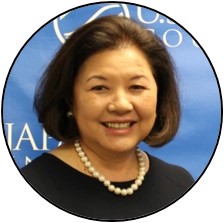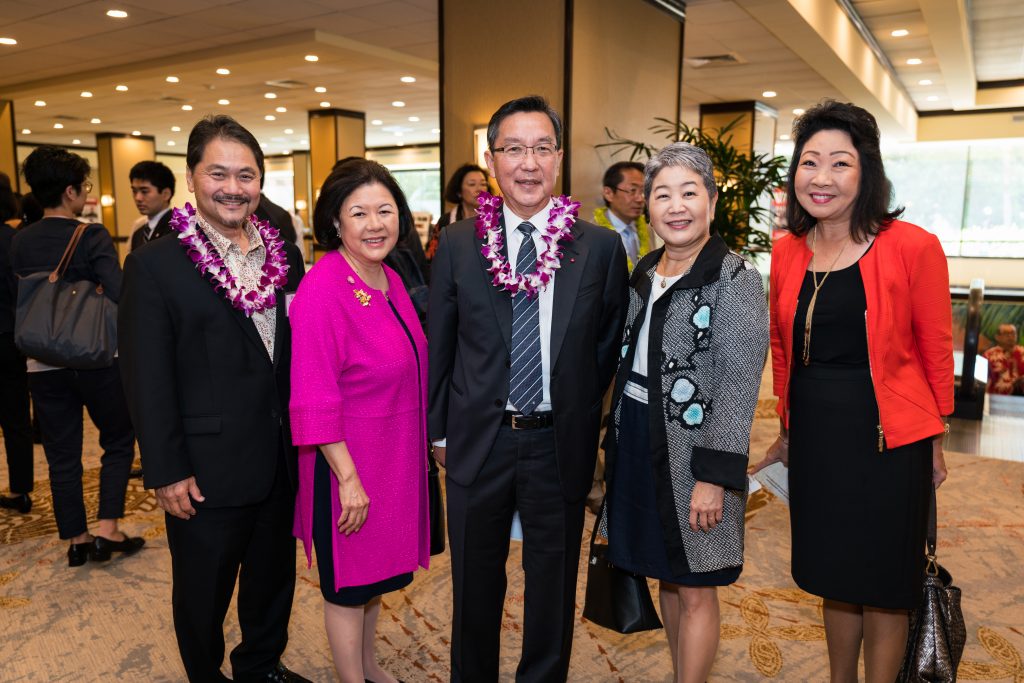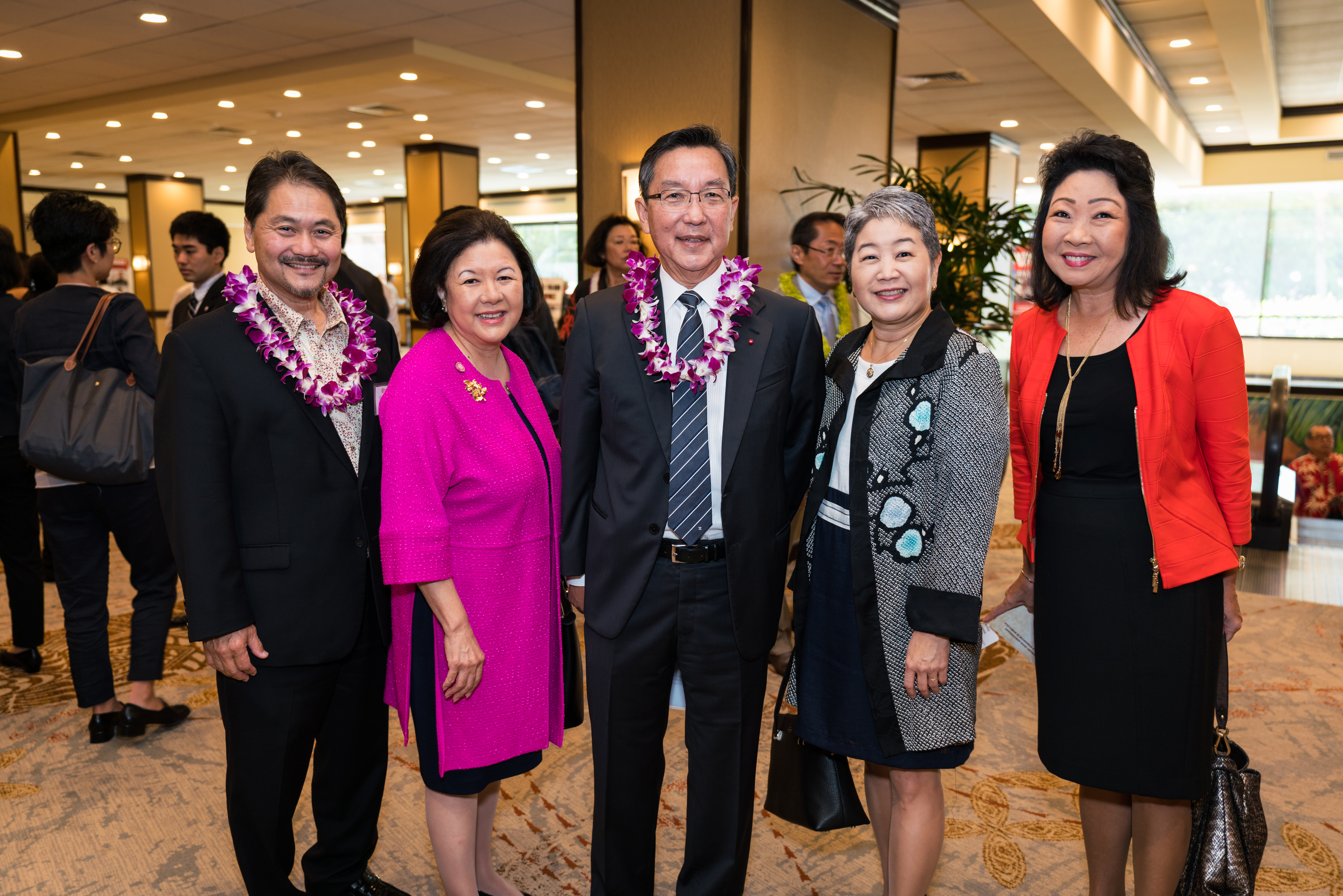Celebrating 150 Years Since the Arrival of the First Japanese Immigrants to Hawaii
- When
–
USJC President Irene Hirano Inouye delivered the following Keynote Speech at the Gannenmono Celebration that was held on the occasion of the 150th Anniversary of the Arrival of the First Group of Japanese Immigrants to Hawaii.

Aloha. I am very pleased to join the distinguished speakers and special guests at this historic Gannenmono Commemoration. We are especially honored that Their Imperial Highnesses Prince & Princess Akishino have traveled to Hawaii to join the Celebration. They have made the Commemoration not only very special but extraordinary.
I would like to congratulate the Kizuna Group, the Gannenmono Committee and the Consulate General of Hawaii for their hard work in organizing the commemorative events this week. Organizations and their leaders, coming together, like the Kizuna Group, is a model that I hope other communities will follow.
I want to welcome those who traveled from throughout the world to attend yesterday’s Annual Convention of the Association of Nikkei and Overseas Japanese. I am grateful that the Association and JICA chose to hold this year’s Convention in Hawaii. I hope that by joining together with so many leaders in Hawaii, we will find many new ways to work together towards common goals.
Today’s program features notable speakers who will be discussing the history and legacy of Japanese Americans—so I would like to focus my remarks this morning on what I believe are opportunities for our future.
I was honored to serve as Founding CEO of the Japanese American National Museum for twenty years. For the past nine years, I have served as the Founding President of the U.S.-Japan Council, an organization that is dedicated to building people-to-people connections to ensure a strong U.S.-Japan relationship. We believe that bringing together Japanese and American leaders, including Japanese Americans leaders, in government, business and the civil sector is critical to ensure a strong foundation between our two countries.
The U.S.-Japan Council was created during a time when people in Washington, DC described U.S.-Japan relations as “Japan Passing.” Many of us did not believe that was true and should not be how Americans considered the importance of our relationship. We believed that Japanese Americans, with our ties to Japan, are in a unique position to strengthen U.S.-Japan relations.

Through the Museum and the U.S.-Japan Council, I have met and worked with extraordinary Japanese American leaders including my late husband, U.S. Senator Daniel K. Inouye. I am sure he would be extremely proud to see so many Nikkei leaders and leaders from Japan coming together in his home state of Hawaii.
I would like to share my thoughts on three themes:
First, we must continue to provide opportunities for Nikkei to connect to and learn about Japan and their Japanese ancestry.
At the same time, we need to find more ways for people in Japan to learn about the Nikkei experience.
I am a Sansei and I grew up in Los Angeles. My grandparents came to the United States in the early 1900’s, and like other Issei, came in search of new opportunities. During World War II, my family like thousands of other Japanese Americans were forced to leave behind everything and were incarcerated in Rohwer, Arkansas, while my father served in the Military Intelligence Service.
After the War, the Issei and Nisei had to rebuild their lives. They worked hard and sacrificed much to enable the Sansei to have every opportunity they were denied. Those who were incarcerated did not talk about the War years. Nisei parents often did not encourage their Sansei children to learn or speak Japanese but to create our identity as Americans first and foremost.
The work to secure the passage of the Civil Liberties Act of 1988, providing redress and token reparations, helped to encourage Japanese Americans to begin to speak about that painful chapter in their lives. This led to many people believing it was important to capture these stories permanently, which included the legacy of the Nisei veterans and those that spoke out against their denial of civil liberties. Thus, the Japanese American National Museum was founded along with historical societies, cultural centers and educational programs to ensure that Japanese American history and culture became part of America’s history.
Our work at the Museum enabled me to learn about the deep impact that the War had on our community. As people shared their stories, I came to realize that because many families were forced to cut ties with Japan during the War, many Sansei and Yonsei had never been to Japan or did not know anything about their ancestry.
And so, in 2000, the Japanese Ministry of Foreign Affairs supported a delegation of 10 Japanese American leaders to travel to Japan. From that initial Delegation, I have had the opportunity to annually accompany the delegations of Japanese American leaders now numbering 18 delegations, of nearly 200 leaders from throughout the country. This important program continues today, in collaboration with the U.S.-Japan Council.
One of the strongest advocates for the importance of the Japanese American community and the role its leaders can play in U.S.-Japan relations is Foreign Minister Taro Kono and his father former Speaker Yohei Kono. Taro Kono has met with every Delegation, which began when he was a young Diet member. Prime Ministers, Diet members, top business leaders and regional Governors and Mayors, have taken the time to meet with delegations and increasingly Japanese leaders visit Japanese American leaders in the U.S. at the urging of the Foreign Minister.
Prime Minister Abe suggested that this year’s Delegation visit his home prefecture, Yamaguchi. We visited the Museum of Japanese Emigration to Hawaii in Yamaguchi. The staff helped two of the Japanese American delegates find information about their ancestors who came from Yamaguchi and emigrated to Hawaii. We also held a successful symposium in Yamaguchi City. There, delegates with ties to Yamaguchi and Hawaii presented upon the very topic we are discussing today: the 150 years since Gannenmono first arrived in Hawaii.
But making a trip to Japan, whether it’s the first trip, or a subsequent trip, is only the beginning. It is the close ongoing connection of alumni to U.S.-Japan relations that has enabled the increasing engagement of Japanese Americans in U.S.-Japan relations.
While we must continue to connect Japanese Americans with Japan, it is equally important that we share the Nikkei experience with people in Japan. This includes not only the Japanese American experience but the experience of Japanese that have emigrated to other parts of North America, South America and to places throughout the world.
Yesterday’s Convention of Nikkei and Overseas Japanese reflects the growing diaspora of Nikkei throughout the world. Over the past several years, I have seen more interest by Japanese to learn about the Nikkei experience. The Japanese Overseas Migration Museum in Yokohama has provided an important place to gather that history. There are more films, books, and educational programs about the Nikkei experience that are being presented in Japan. But the vast majority of Japanese still know very little about our experiences and much work remains to be done.
The second area I would like to address is the changing diversity of our Nikkei community and the role we can all play to be inclusive and collaborative.
When the Japanese American Leadership Delegation Program was just beginning, the program selected Sansei and Yonsei leaders who had never been to Japan.
Increasingly, recent delegations of Japanese American leaders have been more diverse. Of the 10 delegates in the 2018 Japanese American Delegation, only three Delegates had direct family ties to the World War II incarceration experience. In years past nearly everyone had a WWII connection to the camps or the military experience.
We now have a wide range of “Japanese American” life stories. There are Japanese people who came to the U.S. in recent decades for academic or business reasons, and who have since settled here. There are children of Japanese expats who grew up here and went back to Japan but came back to the U.S. to pursue their dreams. There are Japanese Americans living in Japan. There are many Americans who have married Japanese and their children are “Japanese American.”
I often hear concerns that Japanese Americans “marry out” more than other Asian Americans, and that there are fewer recent Japanese immigrants. There is no question that our families are increasingly of mixed heritage. But, I would contend that the Japanese American population is becoming more diverse and in fact “growing” with the increasing number of Japanese who identify with multiple ethnicities.
There is no longer a common definition of “who is Japanese American.” Hawaii has historically reflected a “Mixed Plate” and defined the strength of diversity. What is important is that, despite the differences, the commonality of our Japanese ancestry, through birth, through marriage, or through living in Japan, still ties us together.
My hope is that we will find ways to remove our traditional labels of who is “Japanese American” or who is “Nikkei” and embrace the broadest definitions of our “community.” The War may have divided our community, but now our diversity has become one of our greatest strengths.
My third thought is that I believe we must make a strong commitment to invest in the next generation of Nikkei leaders.
The U.S.-Japan Council is committed to fostering the next generation of Japanese American leaders, through many avenues including an Emerging Leaders Program. This program selects 12 Japanese American leaders, aged 24 to 35 years, from throughout the United States and Japan to attend our Annual Conference and provide them with leadership education training. These young leaders, now over 100, develop powerful, lifelong personal and professional friendships and the alumni of this program remain actively engaged with the work of the Council.
The Emerging Leaders Program is part of the TOMODACHI Initiative, a public-private partnership between the U.S.-Japan Council and the U.S. Embassy in Tokyo, with support from the Government of Japan. This partnership was born out of support for Japan’s recovery from the Great East Japan Earthquake, to give hope to Tohoku youth through study abroad opportunities. It has now expanded to more than 40 programs each year, focusing on leadership development, cultural exchanges and educational exchanges. TOMODACHI supports more than 1,000 Japanese and American youth annually, from not only Tohoku, but throughout Japan and the United States. I have met so many of these young Japanese and Americans since 2012, and with over 6,700 alumni to date, I believe they can change the future with our support.
In closing, I would like to share Dan Inouye’s reflections on winning the 1959 election as U.S. congressman for the new state of Hawaii. Dan, who today is buried in Punchbowl Cemetery in Honolulu, shared these thoughts:
“I went up to the cemetery at Punchbowl and walked alone among the graves of the good men with whom I had served. I wanted to assure them that I would not let them down, never dishonor the cause and the country for which they had given so much. I wanted to promise them that I was not going to Washington to represent the 442, or the Nisei, or any other separate group. I was going to represent all the people of Hawaii and I asked God’s help in this, the greatest undertaking of my life.”
I don’t think Dan could have imagined how much of an impact he would make in his 50+ year career in the United States Congress.
Each of us has an opportunity to make an impact – perhaps not in the same way, but by working together, we can truly make a difference in our work, in our communities, and in the relations between our two countries. Like the Gannenmono, who took a risk to venture to an unknown part of the world 150 years ago, we can be bold and adventurous as we chart new pathways forward.
Let us use today to get to know each other, to learn from each other, to commit to work together, and to create new opportunities for those that will follow us in the future.
Thank you very much. Mahalo.
